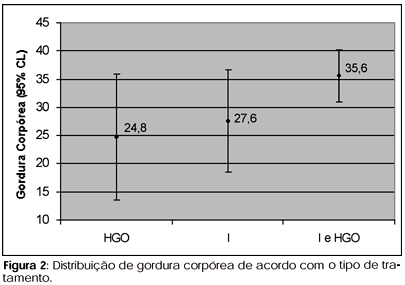We evaluate the relationship between body adiposity (BA) by bioelectrical impedance, body mass index (BMI) and waist circumference (WC) in some clinical and laboratorial parameters in 43 patients with type 2 diabetes (DM2), 26F/17M, matched for age, with a DM duration of 13.6±9.1 years. Women had greater BMI: 30.3±5.4 vs. 26.9±3.0kg/m² (p= 0.04), BA: 35.4±6.2 vs. 19.6±6.2% (p= 0,000), cholesterol: 235± 41 vs. 204±39mg/dL (p= 0,017), triglycerides (TG): 146±61 vs. 116± 57mg/dL (p= 0.06) and HbA1c (HPLC): 7.1±1.7 vs. 6.9±1.4% (p= 0,02) than men, but HDL and LDL cholesterol were not different. When correlated to BA, the following variables were statistically significant: TG, HbA1c, diastolic blood pressure (DBP) and WC. In the stepwise multiple regression analysis using BA, WC and BMI as independent variables and TG (r= 0.34; r²= 0.11; p= 0.02) and DBP (r= 0.39; r²= 0.15; p= 0.008) as the dependent ones, BA was found to be statistically significant. By using the same model having HbA1c as the dependent variable, BA (r= 0.31; r²= 0.10; p= 0.037) and BMI (r= 0.43; r²= 0.19; p= 0.01) became significant. In conclusion, elevated BA in patients with DM2 is an important risk factor to worse metabolic control and blood pressure levels. Women, by virtue of their greater BA and worst plasma lipid profile must need more aggressive intervention to reduce body fat.
Body adiposity; BMI; Glycemic control; Lipid profile; Diabetes





